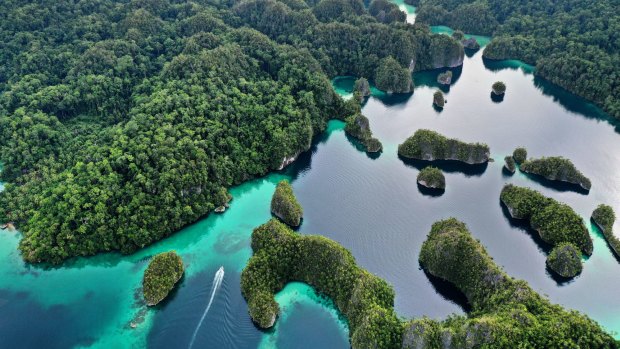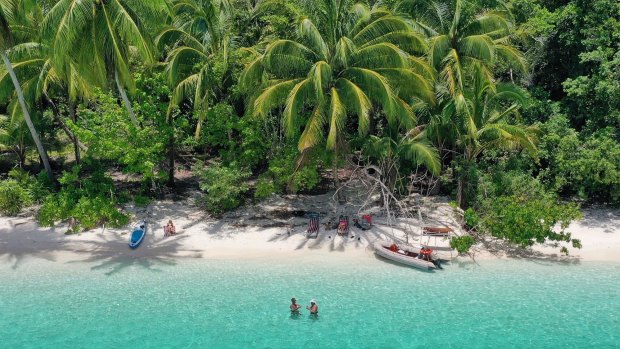This was published 4 years ago
Cruise reveals West Papua's hidden treasures above and below the water
By Julie Miller

The Raja Ampat archipelago in West Papua.
As fruit foragers, hornbills have no evolutionary imperative for silent flight; and when they pass overhead in tenfold formation, I hear their wings cleaving the air – whoosh, whoosh, whoosh. I stop paddling momentarily to watch and listen, my spinning kayak revealing a spellbinding panorama: hills clad in dense virgin rainforest, karst cliffs tumbling into riotous coral gardens, and mushroom islands topped with coconut palms that cling tenaciously to the jagged knife-edge, anchored by a tangle of tubular white lilies.
This is true isolation; I have gone rogue, breaking away from the rest of my paddling party to explore this unnamed fiord near Triton Bay, West Papua, accompanied only by an attentive staff member keeping a respectful distance to ensure my safety. In effect, I am alone in one of the most remote corners of the planet, observing nature in its Garden of Eden purity and wondering how places like this continue to exist.
Described as the "temple of paradise" by Dr Mark Erdmann, senior marine biologist at Conservation International, Triton Bay is just one of the remote anchorages visited during a 10-day journey through southern Raja Ampat and along West Papua's Fak Fak Peninsula on board Kudanil Explorer, a privately owned expedition cruiser offering charter and customised trips through Indonesian waters.

A tropical beach near Triton Bay.
A former oil exploration vessel, the 50-metre Kudanil cuts a striking profile, a far cry both in scale and luxury from the distinctive phinisi dive liveaboards that ply this region, an area rich in biodiversity, healthy reefs and mindboggling underwater sights.
"The beauty of Kudanil is that it can travel faster and further, beyond the usual dive sites," Thibaud Epstein, Kudanil's director of operations tells me as we gaze out over a deserted bay off Batanta Island, one of the so-called "Four Kings" of the Raja Ampat archipelago. "It's also the safest seafaring vessel in these waters – and the most comfortable."
Completely refitted for tourism purposes in 2018, Kudanil (meaning "hippo" in Indonesian) is the epitome of understated elegance, a floating five-star hotel accommodating just 16 guests in eight spacious airconditioned berths, each with a king or two single beds, en suite bathroom, floor-to-ceiling windows and a private terrace with a day bed.
With Balinese-inspired interiors courtesy of Parisian designer Alix Thomsen, the ship eschews formality for comfort, with indoor and outdoor dining areas, a library lounge scattered with coffee table books on Indonesian art and marine life, two bars, and ample deck space to chill on sun lounges. On the "Monkey Island" upper deck is a Jacuzzi for sunset champagne moments; and there's even a little spa for an indulgent massage.
From the moment we board in Sorong, on the north-western tip of West Papua – greeted by Kudanil's exceptional, 19-strong crew with icy cold towels and welcome drinks – shoes are discarded and attitudes checked; this is a journey of relaxation and revelation, with the promise of adventure around every unchartered corner.
Regular itineraries on board Kudanil include surf and dive safaris to Komodo and East Nusa Tenggara, the Spice Islands and Raja Ampat; but this is her first venture into West Papuan waters, with the crew as eager to explore as we are. With dives and all diving gear included in the rates, getting out and under the water is a daily priority; while the ship is also equipped with six transparent kayaks, two paddleboards, water skis and three tenders for poking around hidden beaches and crystal-clear lagoons.
Each evening after dinner, dive master Garry Bevan, an ebullient Englishman with flowing locks who looks uncannily like Benjamin Franklin, runs through the following day's activities, usually consisting of at least one dive or snorkel, and a beach visit, hike or kayak; but the itinerary is flexible and subject to the whim of guests.
On the flip of a coin, for instance, I forgo a strenuous jungle trek and opt instead for a decadent morning lying on a postcard tropical beach, with sun lounges and a makeshift cocktail bar set up in advance.
On another occasion, a chance meeting with some local fishermen selling their wares results in an impromptu beach barbecue, with the West Papuans joining us in a mutually enlightening cultural exchange.
"Today you are here, so today we picnic," the fishermen – who hail from the mainland town of Fak Fak – tell us, proudly setting up camp and charring their catch over an open flame. "Dive boats generally shoo us away. They think we are going to hurt them – but it's OK, we're not murderers!"
As guests in these waters, the Kudanil philosophy is to pay homage to the indigenous owners, asking permission from village elders to use anchorages and beaches.
"Fostering good relations is imperative," Thibaud explains as crew members scout ahead, firming arrangements with local chiefs. "We want them to have a good experience with us, and know that we are respectful, so when Kudanil Explorer returns, we'll be welcomed."
In the pretty West Papuan village of Lobo, spectacularly located near Triton Bay under the rearing, waterfall-carved Mount Emansiri, we are welcomed with song by school children, who then follow in our wake, showing off their ornamental gardens and offering us pomelos and avocados the size of footballs plucked straight off backyard trees.
Only five tourist boats have visited Lobo in the past year, village elder Mr Daniel says as he leads the way through the paved streets, accompanied by Kudanil's Captain Wayung; so for the locals, many of whom are 12th-generation villagers who have never ventured beyond its parameters, this is a significant occasion.
Tourism in this idyllic region may be still in its infancy, but we do witness the occasional concession to visitors: explanatory signs placed at points of ecological or historical importance, for instance; while brand new wooden steps circling Harfat Peak near Misool in Raja Ampat lead to a breathtaking viewpoint of the Thousand Temples Lagoon, a turquoise and green tapestry with our vessel a lone nod to technology, moored in the distance.
But it's under that gin-clear liquid that this utopia reigns supreme. Located in the heart of the Coral Triangle that stretches from Malaysia to the Solomon Islands, the waters off West Papua have the largest diversity of marine life on the planet, with 1500 species of fish and 75 per cent of the world's known coral species. Much of the region is a designated marine reserve, with no-take zones seeing the increase of reef shark populations over the past 15 years.
For divers, this is the Holy Grail; and I can't help but feel a pang of envy as my co-passengers descend below me, their air bubbles champagne kisses as I snorkel on the surface. But even looking down, I am stunned by the frenzy of activity, the explosions of colour and the sheer diversity of Neptune's kingdom.
Giant trevally on the hunt slam into walls of yellow-tailed fusiliers; barracudas flash by like molten silver; while batfish, bumphead parrotfish and weeny neon damsels flit through reassuringly healthy coral gardens, plump and colourful.
But it's alongside traditional fishing platforms, called "bagans'', in Triton Bay that both divers and snorkelers are treated to a marine ballet unlike anything we have witnessed before. In search of a free feed, opportunistic whale sharks – the giants of the fish universe – hang out on a regular basis, as reliable as sunshine, sucking on dangling nets full of baitfish.
With the fishermen happy to sacrifice their catch (at above market price), we swim alongside three of these spangled titans for several hours, eyeballing them as they cruise languidly past, majestically indifferent to our remora-like presence, and dodging swishing tails and gawping vacuum mouths with squeals of equal fear and joy.
Then, drawn to the fun, a pod of 40 dolphins arrive, dipping, diving and cavorting around us with haunting squeaks and whistles. It's playtime; and I'm not sure who's having the most fun.
FIVE MORE WEST PAPUA SIGHTS
BIRDLIFE
Lying beyond the Wallace Line separating south-east Asia from Australasia, the jungles of West Papua boast familiar feathers such as cockatoos and cassowaries, as well as more exotic hornbills and dancing birds-of-paradise.
GREAT VIEWS
Not far from Lobo Village, a newly carved trail and boardwalk above Mauwara Bay provides safe trekking through the jungle, rewarded with deafening birdsong and sensational views from an observation platform.
KITI KITI WATERFALL
This ostentatious gush of water on the Fak Fak Penuinsula tumbles from the cliffs directly into the ocean; kayaking nearby is a little like tackling a white-water river.
JELLYFISH LAKE
Accessed via a rope dangling from razor-sharp volcanic rocks, followed by a perilous, slippery goat trail, this hidden inland lake near Misool is full of thousands of bobbing, golden jellyfish – a truly bizarre phenomenon.
ANCIENT ROCK ART
Ochre rock paintings, depicting dolphins, fish, turtles and hand prints – dating back at least 5000 years – adorn cliffs near Misool and Triton Bay, evidence of ancient seafarers as impressed with the local marine life as we are.
TRIP NOTES
MORE
FLY
Garuda Airlines flies from Sydney and Melbourne to Sorong in West Papua, via Jakarta. Our return flight was from Tual in the Lei Islands, via Ambon and Jakarta. See garuda.com
CRUISE
The Kudanil Explorer is available for exclusive charter (for up to 16 people, minimum six-night cruise) for $US13,500 a night (+10 per cent VAT), with rates including full board, diving and activities. Select dates are also available to individuals at $US1000 a person a night (based on twin/double cabin). See kudanil.com
Julie Miller was a guest of Kudanil Explorer.
Sign up for the Traveller Deals newsletter
Get exclusive travel deals delivered straight to your inbox. Sign up now.